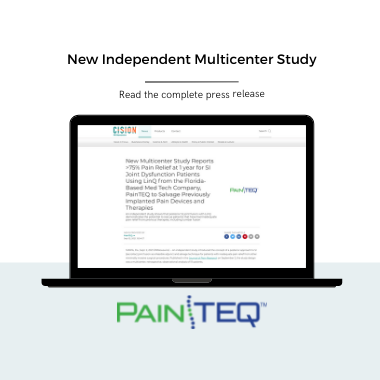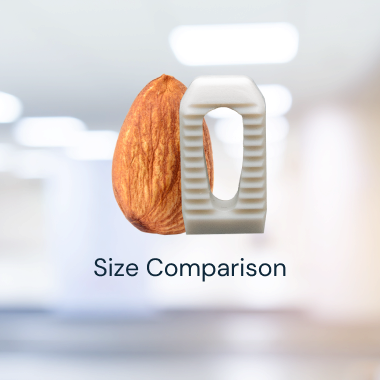SEPTEMBER 03, 2021
New Multicenter Study Reports >75% Pain Relief at 1 year for SI Joint Dysfunction Patients Using LinQ from the Florida-Based Med Tech Company, PainTEQ to Salvage Previously Implanted Pain Devices and Therapies
An independent study shows that posterior SI joint fusion with LinQ demonstrates the potential to rescue patients that have had inadequate pain relief from previous therapies, including lumbar fusion.

TAMPA, FL – September 2, 2021 — An independent study introduced the concept of a posterior approach to SI (sacroiliac) joint fusion as a feasible adjunct and salvage technique for patients with inadequate pain relief from other minimally invasive surgical procedures. Published in the Journal of Pain Research on September 2, the study design was a multicenter, retrospective, observational analysis of 111 patients.
The study utilized the LinQ SI Joint Stabilization System from PainTEQ, a minimally-invasive, single implant designed to encourage long-term fusion and help patients immediately regain joint stability.
Overall, the mean patient-reported pain relief following posterior SI joint fusion was 67.6%. In patients with a history of failed back surgery syndrome, the mean patient-reported pain relief was 76.5%.
“This publication validates what I have seen in my own practice,” said Christopher Bovinet, DO, one of the key investigators in the study. “With the LinQ procedure, we can successfully and reliably treat refractory sacroiliac joint pain in a minimally-invasive fashion for our patients. This is not only in those whom SI joint steroid injections or RFAs fail, but also other advanced interventions.”

Given the complexity of the SI joint and how common SI joint dysfunction is, it should be expected that many patients continue to have pain following traditional therapies. In the Salvage Study, patients with continued, intolerable pain following traditional therapies (physical therapy, steroid injections, ablation, spinal fusion, etc.) experienced significant pain relief in a salvage manner.
“A patient may suffer from spinal pain from more than one generator. When previous interventions failed to provide relief, it may be an untreated pathology of the SI joint – one of the most common causes of persistent back pain after surgery,” said Timothy Deer, MD, another key investigator of the research. “In this study, we address salvaging a good outcome by addressing this pain etiology.”

“These are fantastic patient outcomes at one year for the LinQ system from leading investigators in the interventional field,” said Shanth Thiyagalingam, Chief Commercial Officer, PainTEQ. “PainTEQ’s commitment to clinical evidence and patient outcomes as demonstrated in this publication will help increase awareness of the LinQ system to help more patients suffering from sacroiliac joint dysfunction and pain as we scale the commercial launch of the LinQ system.”

About PainTEQ: Built to bring interventional procedures to the market, PainTEQ is a medical device innovator headquartered in Tampa, Florida. PainTEQ works with pain management specialists to safely reduce and eliminate SI joint dysfunction, PainTEQ’s LinQ therapy helps patients with low back pain through a minimally invasive, outpatient procedure.
About LinQ: The LinQ SI Joint Stabilization System provides SI joint dysfunction patients with a minimally invasive treatment to combat pain. After a thorough diagnostic process, physicians can help alleviate, and in many cases, eliminate sacroiliac joint pain through PainTEQ’s patented LinQ procedure. LinQ’s patented drill-less approach helps patients immediately regain joint stability with a shorter recovery time than traditional fusion. Learn more at PainTEQ.com.
###
Contact Information:
855.248.PAIN



